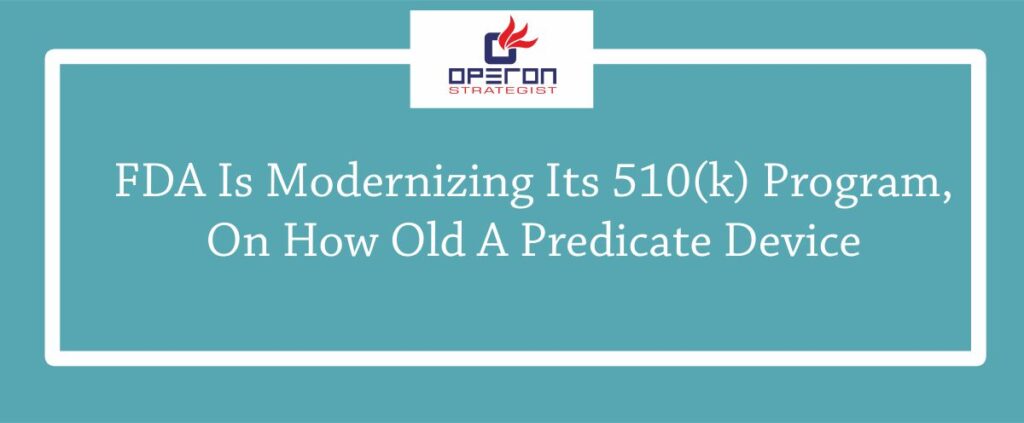Food and Drug Administration’s modernization plan for its 510(k) Program may not be all sweet music to the industry. In a joint statement on Monday describing the modernization effort, Commissioner Scott Gottlieb and Jeffrey Shuren, director of the Center for Devices and Radiological Health, said that the agency is considering placing a 10-year limit on older predicates. In other words, if you as a medical device manufacturer are developing a product with a predicate to gain 510(k) market clearance, then that predicate cannot have been introduced to the market more than 10 years ago.
“Our objective in concentrating on more established predicates is to drive supporters to constantly offer patients devices with the most recent upgrades and advances,\” the announcement read.
The 510(k) program of course is the most-used regulatory pathway for devices that are “substantially equivalent” to an already legally marketed device, known as a predicate device. Last year, the CDRH cleared 3,173 through the 510(k) process, representing 82 percent of all medical devices cleared or approved by the FDA.
The program has been scrutinized heavily for several years as reports of serious adverse events have rocked the industry from time to time. Back in 2011, a year after Shuren took over as CDRH director, the Institute of Medicine made a dire assessment recommending that the agency must abandon the 510(k) pathway altogether.
FDA never accepted that recommendation but in recent years has made what it believes are efforts to alter and improve the program and encourage innovation while focusing on safety as well. It is the same dual interest that is driving the idea of sunsetting certain older predicates.
In their statement, Messers Shuren and Gottlieb go on to clarify that they in no way intend to pull products with older predicates off the market or imply that they are unsafe. The desire is to simply encourage “product developers to use more modern predicates” that would give “patients and their doctors a choice among older and newer versions of a type of device” in addition to “boosting competition to adopt tech features that improve a device’s safety and performance.”
Were this to occur, it represents a big, fundamental shift in how the 510(k) program. According to the FDA nearly 20 percent of current 510(k)s are cleared based on a predicate that’s more than 10 years old. Not surprisingly, the device industry association did not like what it heard.
“It is our hope that through the regulatory review, the agency will recognize that in some cases there are legitimate reasons for using older predicates, and that for some devices where the technology has changed little using those older predicates still makes sense,” The proposed 10-year cut off criteria could demonstrate self-assertive as more established predicates can offer broad information about their execution, which enables sponsors to present newer , more secure devices.”
One regulatory attorney implied that the FDA may be overreaching in its attempt to limit the time period when choosing an older predicate.
“If FDA believes this is an issue, the appropriate forum for discussing it is Congress,” said Bradley Merrill Thompson, an attorney with Becker Epstein Green, in an email. “The 1976 statute is very clear, and FDA can’t simply ignore it. If FDA wants to change the statute, then to Congress they should go. Congress in turn could bring together all of the various stakeholders including patients, healthcare professionals and medical device manufacturers to talk about the they need and the best way to do this. FDA has no mandate to do this on its own.
In a way, FDA has already forged its own path given that with the introduction of the FDA pre-certification program for software, the agency essentially bypassed Congress. But the statement from Shuren and Gottlieb acknowledge that some of these policy proposals may require “additional support from Congress.”
Another regulatory expert also believes that the 10-year sunset may be a tough road to hoe for FDA.
“The statement is also, in part, aspirational on how the agency can address clearing devices more efficiently without compromising safety and effectiveness,” wrote Kathleen McDermott, a partner from Morgan Lewis, in an email. “In proposing to sunset predicate devices older than 10 years, some of which have decades of safety and performance data, the agency will have to be clear in the standards being developed or risk uncertainty and unpredictability.”
More significantly, however, the statement showed that the agency is also creating an alternative 510(k) framework and will finalize it in early 2019 called the “Safety and Performance Based Pathway.” That will rely on objective safety and performance criteria to demonstrate substantial equivalence, instead of relying on sometimes decades-old predicate devices.
Perhaps in a nod to the makers of the Bleeding Edge, the compelling Netflix documentary that savaged the 510(k) program by telling the stories of patients hurt by defective implants, the FDA statement made clear that the agency will continue to change the classification of certain devices deemed more risky than initially when they were cleared under the 510(k) pathway. The statement noted:
Through a procedure known as “up-classifying” – implying that we are re-appointing a device to Class III and requiring premarket approval, our most stringent review pathway, before a device can stay available – we can and have made ineligible the utilization of specific devices as legitimate predicates. Explicit precedents incorporate the upclassification of recently cleared 510(k)s for vaginal mesh for the treatment of pelvic organ prolapse, mechanized external defibrillators, and metal-on-metal hip implants. These devices are higher risk and can never again be conveyed to advertise by means of the 510(k) pathway.
For instance in January 2016, transvaginal mesh devices — that scarred and hurt many women — went from the less-moderate Class II classification to the more stringent Class III category, which meant that these devices would then on be required to be approved under the more taxing PMA (premarket approval) pathway.
Meanwhile, while FDA clarified its stance on these higher-risk devices, other safety questions loom. The International Consortium of Investigative Journalists has just published an investigative series on problematic implants and the medical device industry in general that is bound to cast a long shadow over the regulatory path. NBC News has also published an article about how U.S.-made devices have hurt patients abroad.
The risk from medical devices is not unknown to FDA and in Monday’s statement, Shuren and Gottlieb observe that the agency is beefing up post-market surveillance efforts. Earlier it created the National Evaluation System for health Technology (NEST), an active surveillance system that will real-world evidence and safety information. But on Monday the statement showed that the agency is committed to a “new strategic goal: Guaranteeing that the FDA is reliably first among the world\’s regulatory agencies to recognize and follow up on security signals identified with medical devices.”
- adminhttps://operonstrategist.com/author/admin-2/
- adminhttps://operonstrategist.com/author/admin-2/
- adminhttps://operonstrategist.com/author/admin-2/
- adminhttps://operonstrategist.com/author/admin-2/




